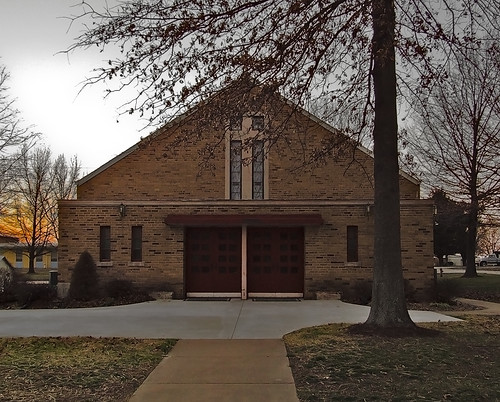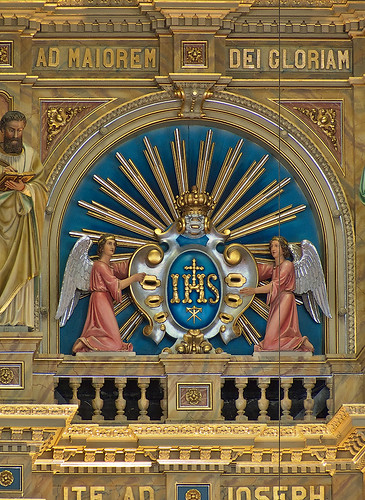It wasn't 'superficial' or considered a waste to honor God with their best in skill and artistry. They didn't spend their lot in life on themselves, but for the Church, and for posterity, and here we are, so many years later, enjoying the wonder and majesty of creation, and the way our spirits soar to heaven just gazing upon these masterpieces.
Pages
▼
Thursday, January 31, 2008
"House of God...Catholic style"
House of God...Catholic style is an article at the blog RECONnecting to the TRUTH.
The Philosophy of "Self-Identification"
POPE BENEDICT XVI, at his recent General Audiences, has been talking about Saint Augustine of Hippo (a.d. 354-430), Latin Father and Doctor of the Church, and the relationship between faith and reason.
Saint Augustine was a great philosopher as well as theologian and bishop, and among many things, is known for his writings on the relationship between Church and State, and the relationship between Faith and Reason. He has quite a lot to say to our current divided age.
Even as a heretic in his young adulthood, Augustine was always attracted to Christianity, but was intellectually repulsed by Scripture. Pope Benedict discusses how Augustine reverted to Christianity, due to the influence of Saint Ambrose of Milan (340-397):
Ground Zero of the Culture War against orthodoxy in the United States is currently in the Archdiocese of Saint Louis. Archbishop Burke has the unenviable task of correcting a number of media-prominent individuals who claim to be members of the Catholic Church, yet refuse to yield to the teachings and discipline of the Catholic Church. The names of Bozek, McGrath, Hudson, and Majerus are portrayed by the popular media as being heroes against the power of the Archbishop, even to the point where ordinary Catholics are being swayed to the popular opinion.
While it is inconceivable that any other organization would be denied the authority to regulate its own membership, this doesn't seem to apply to religion, especially Catholicism, in the United States. Imagine the power that would come down upon an individual who would dare to independently market a product called Coca-Cola, or who would unilaterally proclaim himself free from the obligation to pay taxes to the Federal Government. How did this despicable attitude arise?
The Catholic Church historically selected the year 1274, the year of the death of Saint Thomas Aquinas, as the beginning of the Modern Age. This philosopher, theologian, and mystic did much to unify Faith and Reason, as well as to describe the proper relation between Church and State, and so can serve as the other bookend to Augustine in defining the Catholic Age. After the death of Aquinas, the Bubonic Plague and widespread wars destroyed much of Western Europe and Medieval culture, and so higher education, and especially philosophy, was nearly lost.
After Aquinas, we can see various threads of the modern world come together in the person of William of Occam (1288-1347), a Franciscan scholar. Most famous for "Occam's Razor", or the law of parsimony — entities should not be multiplied beyond necessity — this rule of reductionism led to the development of the scientific method, but ultimately leads to solipsism, the view that only the self exists. Lesser known is his novel doctrine of sola fide — faith alone — regarding religion. From William of Occam we get the modern divorce between Faith and Reason. William also developed the philosophy of Nominalism, a skeptical philosophy, that denies universal entities, and so therefore eventually denies the concept of truth. He also was a proponent of the theory of secular absolutism, where the Monarch has total rule over all aspects of his realm. William indeed sided with the secular authority against the Pope, although he eventually died reconciled with the Church.
After William, Western Europe followed in his intellectual footsteps, with Kings claiming absolute power, and in Protestantism, where religious leaders were no longer were bound by reason, but by their own individual feelings. In the Modern world, secular rulers claim absolute authority, and religion is arbitrary. Church and State, and Faith and Reason are divorced.
The idea that words mean things, and that things are represented by words, is distinctively human; but this is denied by the philosophy of Nominalism. Animals see words as being mere signals, and so Nominalism reduces humanity to the level of the animals. Words, to the modern philosophers, are just arbitrary vocalizations that signal us human animals to perform tricks; and like dogs, we get a treat if we respond correctly, and punishment if we do not.
To the moderns, the word 'Catholic' is just another meaningless vocal utterance, used by the media to make us animals perform tricks. We hear of two women invalidly and illegally attempting to become ordained to the Catholic priesthood, and those who respond 'correctly', by accepting it, are rewarded, while those who respond 'incorrectly' to this, like our Archbishop, are punished. But to them, these words 'Catholic' and 'priest' don't mean anything, although they mean something to us, and we also claim that these have a higher reality.
Sola fide, Nominalism, Reductionism, and the cult of the Self are all closely intertwined, and so we should not be surprised by the phenomena of self-identification. According to this theory, if a person self-identifies himself a Catholic, then he is, despite any external appearances. This denies the Church the authority to regulate its members. We hear of a parish defying its local Ordinary, cutting itself off from the Church and her doctrine, yet still calls itself Catholic. Or we hear of individuals denying the teaching authority of the Church, but still calling themselves Catholic. When self-identification is validated, words are drained of all meaning.
Until lately, this form of self-identification was primarily restricted to religion, but now is being used in other areas. 'Gender' activists use the words 'male' and 'female' in ways that are unrelated to physiological sexuality, and hold to the line that a person has the right to self-identify his/her/its gender. That activists use the grammatical term 'gender' rather than the physical term 'sex' tells us that perhaps they are playing word games, with the words being meaningless.
Playing fast and loose with the truth on the personal level becomes tyranny on the governmental level. It is not surprising that rulers who subscribe to the modern theories become absolutist, for they bow to no authority other than themselves.
As Pope Benedict often tells us, we need a return to sound philosophy. Like Saint Augustine, we need to discover the proper relationships between Faith and Reason, and the City of God and the City of Man.
Saint Augustine was a great philosopher as well as theologian and bishop, and among many things, is known for his writings on the relationship between Church and State, and the relationship between Faith and Reason. He has quite a lot to say to our current divided age.
Even as a heretic in his young adulthood, Augustine was always attracted to Christianity, but was intellectually repulsed by Scripture. Pope Benedict discusses how Augustine reverted to Christianity, due to the influence of Saint Ambrose of Milan (340-397):
...The great difficulty with the Old Testament, because of its lack of rhetorical beauty and lofty philosophy was resolved in St Ambrose's preaching through his typological interpretation of the Old Testament: Augustine realized that the whole of the Old Testament was a journey toward Jesus Christ. Thus, he found the key to understanding the beauty and even the philosophical depth of the Old Testament and grasped the whole unity of the mystery of Christ in history, as well as the synthesis between philosophy, rationality and faith in the Logos, in Christ, the Eternal Word who was made flesh.This harmonization of faith and reason, done with a unified view of Scripture and a realist philosophy, is a pillar of Catholicism, and indeed is even found worldwide in ancient religions that have a more-or-less orthodox world view. It is not, however, the view taken by liberal intellectuals and most of modernist religion, who wage a powerful war against catholic culture.
Augustine soon realized that the allegorical interpretation of Scripture and the Neo-Platonic philosophy practised by the Bishop of Milan enabled him to solve the intellectual difficulties which, when he was younger during his first approach to the biblical texts, had seemed insurmountable to him.
Thus, Augustine followed his reading of the philosophers' writings by reading Scripture anew, especially the Pauline Letters....
Ground Zero of the Culture War against orthodoxy in the United States is currently in the Archdiocese of Saint Louis. Archbishop Burke has the unenviable task of correcting a number of media-prominent individuals who claim to be members of the Catholic Church, yet refuse to yield to the teachings and discipline of the Catholic Church. The names of Bozek, McGrath, Hudson, and Majerus are portrayed by the popular media as being heroes against the power of the Archbishop, even to the point where ordinary Catholics are being swayed to the popular opinion.
While it is inconceivable that any other organization would be denied the authority to regulate its own membership, this doesn't seem to apply to religion, especially Catholicism, in the United States. Imagine the power that would come down upon an individual who would dare to independently market a product called Coca-Cola, or who would unilaterally proclaim himself free from the obligation to pay taxes to the Federal Government. How did this despicable attitude arise?
The Catholic Church historically selected the year 1274, the year of the death of Saint Thomas Aquinas, as the beginning of the Modern Age. This philosopher, theologian, and mystic did much to unify Faith and Reason, as well as to describe the proper relation between Church and State, and so can serve as the other bookend to Augustine in defining the Catholic Age. After the death of Aquinas, the Bubonic Plague and widespread wars destroyed much of Western Europe and Medieval culture, and so higher education, and especially philosophy, was nearly lost.
After Aquinas, we can see various threads of the modern world come together in the person of William of Occam (1288-1347), a Franciscan scholar. Most famous for "Occam's Razor", or the law of parsimony — entities should not be multiplied beyond necessity — this rule of reductionism led to the development of the scientific method, but ultimately leads to solipsism, the view that only the self exists. Lesser known is his novel doctrine of sola fide — faith alone — regarding religion. From William of Occam we get the modern divorce between Faith and Reason. William also developed the philosophy of Nominalism, a skeptical philosophy, that denies universal entities, and so therefore eventually denies the concept of truth. He also was a proponent of the theory of secular absolutism, where the Monarch has total rule over all aspects of his realm. William indeed sided with the secular authority against the Pope, although he eventually died reconciled with the Church.
After William, Western Europe followed in his intellectual footsteps, with Kings claiming absolute power, and in Protestantism, where religious leaders were no longer were bound by reason, but by their own individual feelings. In the Modern world, secular rulers claim absolute authority, and religion is arbitrary. Church and State, and Faith and Reason are divorced.
The idea that words mean things, and that things are represented by words, is distinctively human; but this is denied by the philosophy of Nominalism. Animals see words as being mere signals, and so Nominalism reduces humanity to the level of the animals. Words, to the modern philosophers, are just arbitrary vocalizations that signal us human animals to perform tricks; and like dogs, we get a treat if we respond correctly, and punishment if we do not.
To the moderns, the word 'Catholic' is just another meaningless vocal utterance, used by the media to make us animals perform tricks. We hear of two women invalidly and illegally attempting to become ordained to the Catholic priesthood, and those who respond 'correctly', by accepting it, are rewarded, while those who respond 'incorrectly' to this, like our Archbishop, are punished. But to them, these words 'Catholic' and 'priest' don't mean anything, although they mean something to us, and we also claim that these have a higher reality.
Sola fide, Nominalism, Reductionism, and the cult of the Self are all closely intertwined, and so we should not be surprised by the phenomena of self-identification. According to this theory, if a person self-identifies himself a Catholic, then he is, despite any external appearances. This denies the Church the authority to regulate its members. We hear of a parish defying its local Ordinary, cutting itself off from the Church and her doctrine, yet still calls itself Catholic. Or we hear of individuals denying the teaching authority of the Church, but still calling themselves Catholic. When self-identification is validated, words are drained of all meaning.
Until lately, this form of self-identification was primarily restricted to religion, but now is being used in other areas. 'Gender' activists use the words 'male' and 'female' in ways that are unrelated to physiological sexuality, and hold to the line that a person has the right to self-identify his/her/its gender. That activists use the grammatical term 'gender' rather than the physical term 'sex' tells us that perhaps they are playing word games, with the words being meaningless.
Playing fast and loose with the truth on the personal level becomes tyranny on the governmental level. It is not surprising that rulers who subscribe to the modern theories become absolutist, for they bow to no authority other than themselves.
As Pope Benedict often tells us, we need a return to sound philosophy. Like Saint Augustine, we need to discover the proper relationships between Faith and Reason, and the City of God and the City of Man.
Flowers at Shaw's Garden
THE COLD of winter and its overcast skies give us drab landscapes, nearly lacking in all but the most muted of colors. In this dark season, it is a delight to visit the greenhouses of the Missouri Botanical (Shaw's) Garden. Enjoy these photos, taken last week.




























Monday, January 28, 2008
Tuesday, January 22, 2008
Reducing All to Ashes
A DISTINCTIVE FEATURE of contemporary life is the incredible concentration of power in the political, cultural, and economic spheres, joined with the absurd claim that "the people" now have far greater freedom. However, it seems that just about the only "freedom" now granted is that of sexual license, while the undeniable freedom of individuals to cooperate together to regulate their own affairs is curtailed.
The United States Supreme Court cases, Roe v. Wade and Doe v. Bolton, both decided on January 22nd, 1973, together essentially made abortion-at-will the law of the land, and arbitrarily overturned innumerable local and state laws restricting that despicable practice. Seven out of nine Supreme Court justices concurred with the decision, and the other two dissented.
It would be too easy to blame economic causes for this decision, like for example, the fact that both big business and big government want as many people as possible to have paid jobs, because it is good for consumer spending and tax revenue, and that the raising of children takes valuable workers away from the economy; in this system, new workers will come from immigration. Ultimately, we know that the root cause of this problem is sin: separation from God, and hence, from each other. This separation leads us to grasp at things that won't make us blessed, and it darkens our reason.
This darkening of reason is apparent in our public philosophy, which cannot answer the questions "What is Man?" and "What is the greatest good?" What is horrifying is that the logical conclusion of these modern philosophies is nothing less than total annihilation. Abortion, euthanasia, and eugenics are merely mild symptoms of this kind of spiritual sickness, the end of which sickness, if left unchecked, can only be attempted omnicide: the killing of everything.
According to the philosophic writer Walker Percy (1916-1990), the man who separates himself from God and other men becomes like a ghost who is lost in the cosmos, inhabiting a place where he cannot belong, constantly seeking a self-identity. If such a man eventually places his Self in something lesser than himself — which is idolatry or fetishism — the very probable loss the fetish leads to a loss in self-identity. Losing your self is the very worst state imaginable in this life. Such a person, we say, has lost his conscience, even his soul, and if unchecked, the end result is his desire to reduce all of the world to the same void that is his own self.
This is the psychology of damnation.
In fiction, this desire to destroy all can be seen in the Der Ring des Nibelungen and the Lord of the Rings, and in both works, this will to universal destruction is due to the loss of the fetish of the Ring of Power. In history, Hitler, the ruler of the German Third Reich, upon the loss of his war, ordered the destruction of his nation by his retreating troops, and then committed suicide. We also see this desire for destruction in the increasingly frequent mass murder/suicides perpetrated.
The psychology of the self is a reason why concentrated power should be avoided at all costs. A great leader, no matter how virtuous, may lose himself, and thereafter use his substantial power for total destruction. But we must not ignore the possibility of grace. Just seven Supreme Court justices legalized abortion in the United States; but grace, in a single moment, with a single person, can change the direction of entire nations. An old Chinese proverb has an Emperor say, "I drank a cup of green tea and ended a war": minuscule changes can indeed have profound effects. The end to abortion and the other hatred of life will most likely happen in a way that is subtle and unpredictable, which is why we must work diligently and lovingly with everyone we meet.
The United States Supreme Court cases, Roe v. Wade and Doe v. Bolton, both decided on January 22nd, 1973, together essentially made abortion-at-will the law of the land, and arbitrarily overturned innumerable local and state laws restricting that despicable practice. Seven out of nine Supreme Court justices concurred with the decision, and the other two dissented.
It would be too easy to blame economic causes for this decision, like for example, the fact that both big business and big government want as many people as possible to have paid jobs, because it is good for consumer spending and tax revenue, and that the raising of children takes valuable workers away from the economy; in this system, new workers will come from immigration. Ultimately, we know that the root cause of this problem is sin: separation from God, and hence, from each other. This separation leads us to grasp at things that won't make us blessed, and it darkens our reason.
This darkening of reason is apparent in our public philosophy, which cannot answer the questions "What is Man?" and "What is the greatest good?" What is horrifying is that the logical conclusion of these modern philosophies is nothing less than total annihilation. Abortion, euthanasia, and eugenics are merely mild symptoms of this kind of spiritual sickness, the end of which sickness, if left unchecked, can only be attempted omnicide: the killing of everything.
According to the philosophic writer Walker Percy (1916-1990), the man who separates himself from God and other men becomes like a ghost who is lost in the cosmos, inhabiting a place where he cannot belong, constantly seeking a self-identity. If such a man eventually places his Self in something lesser than himself — which is idolatry or fetishism — the very probable loss the fetish leads to a loss in self-identity. Losing your self is the very worst state imaginable in this life. Such a person, we say, has lost his conscience, even his soul, and if unchecked, the end result is his desire to reduce all of the world to the same void that is his own self.
This is the psychology of damnation.
In fiction, this desire to destroy all can be seen in the Der Ring des Nibelungen and the Lord of the Rings, and in both works, this will to universal destruction is due to the loss of the fetish of the Ring of Power. In history, Hitler, the ruler of the German Third Reich, upon the loss of his war, ordered the destruction of his nation by his retreating troops, and then committed suicide. We also see this desire for destruction in the increasingly frequent mass murder/suicides perpetrated.
The psychology of the self is a reason why concentrated power should be avoided at all costs. A great leader, no matter how virtuous, may lose himself, and thereafter use his substantial power for total destruction. But we must not ignore the possibility of grace. Just seven Supreme Court justices legalized abortion in the United States; but grace, in a single moment, with a single person, can change the direction of entire nations. An old Chinese proverb has an Emperor say, "I drank a cup of green tea and ended a war": minuscule changes can indeed have profound effects. The end to abortion and the other hatred of life will most likely happen in a way that is subtle and unpredictable, which is why we must work diligently and lovingly with everyone we meet.
Photo of Saint Lawrence Church, in Lawrenceton, Missouri
HERE IS A PHOTO of Saint Lawrence Church, in Lawrenceton, Missouri. The church is in western Sainte Genevieve County, and is 58 highway miles south of downtown Saint Louis.

According to an anonymous history of the town, published on the Web by Valerie Holifield:

According to an anonymous history of the town, published on the Web by Valerie Holifield:
As the early settlers came through the region northwest of Ste. Genevieve on their way to the mining region near Bonne Terre, MO, they often passed through the small beautiful valley west of Bloomsdale. The beauty of this place, nestled between two small hills, inspired one traveler to remark about how much it resembled the beautiful region of Punjaub, India, and thus, the official name of Punjaub was given to the village, which became an important trading center in the late 1860's and early 1870's.Click here for a location map.
By 1870, two brothers, Henry and Charles Lawrence, were living on a farm just west of Punjaub. From newspaper accounts, we have learned that these men were very industrious. Sensing a need for a local source of supplies, they established a large general store and flour mill in Punjaub. There was also a blacksmith shop, which was purchased by Andrew Oberle in 1879, and operated by his family and other various owners, until it was closed in 1930 by Anton Dennis. Barrels were made in the [cooper] shop of Mr. Bell. A small, spring-fed stream running through the village provided power to operate these industries.
In 1880, Henry Lawrence and his wife, Caroline, donated the land and registered the plans for the town of Lawrenceton, with lots, streets, and the highway measured and laid out for public use. At the same time, they designated one lot for the use of a public school.
Realizing the importance of a local church, Henry Lawrence and his wife, Caroline, and Charles Lawrence and his wife, Philomena, gave 10 acres of land in 1870 for the use of the Catholic congregation of Punjaub. The church, named St. Lawrence, influenced the choice of the name Lawrenceton for the village.
The first church's cornerstone, which still exists, was laid in 1870, and the church was dedicated by the Vicar-General Muehlsiepen in 1872, with Rev. Peter Mollenbeck being the first pastor. After his departure, Father Henry Mehring cared for the Lawrenceton and French Village parishes until 1878. Fathers Reding and Grosholz were next and pastored St. Lawrence exclusively, until 1882, when the churches at Lawrenceton and French Village were served by Father A. Huettler, in residence at Bloomsdale. By 1887, Rev. Charles L. VanTourenhout was put in charge at Lawrenceton with French Village as its mission parish. It continued as a mission parish of St. Lawrence for many years.
Early church records show the first baptism was in 1872, the first confirmation in 1879, and the first burial in 1912. It is thought that Lawrence Bookholtz was the first one baptized in St. Lawrence Church.
In 1917, a devastating tornado hit the church demolishing all but the entrance and blowing some of the records across the Mississippi River into Illinois. The church was rebuilt during the pastorate of Rev. Frank X. Weinig, and dedicated in 1918 by Most Rev. John J. Glennon. Other improvements have been made, and in 1942, a different entrance was built, including a statue of Mary, Queen of Peace, donated in memory of Pauline Glaser Kohler by her children.
In 1965, at the time of Father John Jadrich's pastorship, St. Lawrence Catholic Church has been administrated by the pastor of St. Agnes church at Bloomsdale. Following Rev. Jadrich, Father John Majewski served both parishes for 15 years. At present, Rev. Vincent Huels cares for both parishes.
The general store built and run by the Lawrences was later purchased by Daniel Loida and run by his family. During the rebuilding of the church, services were held upstairs in the store. Around 1920, Dominic Lichtfuss was operating the store, a post office, and a tailor shop. The large general store has been torn down and made into a residence. By 1922, James Carron was running a small store and gas station in Lawrenceton. Leroy and Pauline Reidt bought this store and station and ran them until 1950. There is no store or other business in Lawrenceton at the present time. The post office was closed in the early 1940's as an economic measure by the U.S. Postal Department, and Lawrenceton is now served from the Bloomsdale post office. With the consolidation of the county schools in 1947, Lawrenceton public school was closed, and the children were bussed to other schools.
Monday, January 21, 2008
Upcoming Events at the Oratory
From the bulletin of Saint Francis de Sales Oratory, in Saint Louis:
SUNDAY, JANUARY 27, EXTERNAL SOLEMNITY OF THE FEAST OF ST. FRANCIS DE SALES
Patron of the Oratory and of the Institute of Christ the King.
10am: Solemn High Mass
The faithful attending the Masses and devotions to St. Francis de Sales may receive a plenary indulgence under the ordinary conditions.
TUESDAY, JANUARY 29, FEAST OF ST. FRANCIS DE SALES
6:30pm, Solemn High Mass
FRIDAY, FEBRUARY 1, FIRST FRIDAY
6:30pm, Solemn High Mass: Votive Mass of the Sacred Heart, w/ Benediction
SATURDAY, FEBRUARY 2, CANDLE MASS
8am: Solemn High Mass with Blessing of the Candles with procession. Blessing of the throats
SUNDAY, FEBRUARY 3-TUESDAY FEBRUARY 5
40 Hours Devotion begins
SUNDAY, FEBRUARY 3, PONTIFICAL MASS
7:30-11:30am Confessions
10am: Pontifical Mass, celebrated by His Excellency, the Most Rev. Robert Hermann, V.G., Auxiliary Bishop in St. Louis, and Procession with the Blessed Sacrament. 6pm. Reposition of the Blessed Sacrament.
MONDAY, FEBRUARY 4, 40 HOURS
7:30am, Confessions; 8am Low Mass and Exposition of the Blessed Sacrament. 11:30am Confessions; 12:10pm, Low Mass at St. Joseph’s Altar; 6pm, Confessions; 6:30pm, Solemn High Mass.
TUESDAY, FEBRUARY 5, 40 HOURS
7:30am, Confessions; 8am Low Mass and Exposition of the Blessed Sacrament; 11:30am Confessions; 12:10pm, Low Mass at St. Joseph’s Altar; 6pm, Confessions; 6:30pm, Solemn High Mass, Conclusion of the 40 Hours Devotion: Procession and Benediction.
WEDNESDAY, FEBRUARY 6, ASH WEDNESDAY
7:30am Confessions; 8am Low Mass; 11:30am, Confessions; 12:10pm, Low Mass; 6pm, Confessions; 6:30pm Solemn High Mass. At ALL Masses blessed ashes will imposed.
FRIDAY, FEBRUARY 8, STATIONS OF THE CROSS
6pm, Confessions; 6:30pm, Low Mass; followed by Stations of the Cross.
March 7 & 8, Lenten Retreat at the Oratory in Cooperation with Credo of the Catholic Laity.
TUESDAY EVENINGS…
Our Mother of Perpetual Help devotions at 6:30pm every Tuesday after Holy Mass at her altar. This is a great way to show Our Lady we appreciate her and dedicate ourselves to her.
THURSDAY NIGHTS…
Adoration of the Most Blessed Sacrament followed by Benediction every Thursday night at 6:30pm.
Photos of Saint Anne Mission, in French Village, Missouri
HERE ARE PHOTOS of Saint Anne Mission, in French Village, a rural unincorporated settlement in eastern Saint François County, Missouri. The church is about 57 highway miles south of downtown Saint Louis.
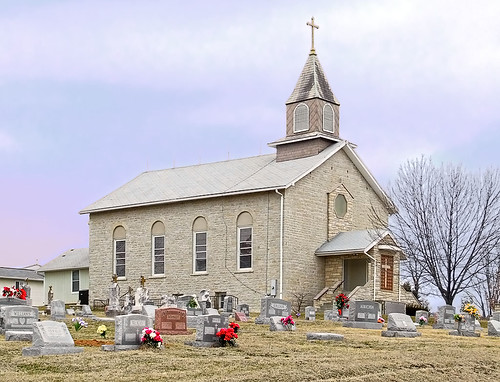
According to a plaque on the front of the church:
The cemetery has a predominance of French and Irish names — these two nationalities having a long history of good relations — as well as a scattering of eastern European surnames. The name 'Aubuchon' seems to predominate here, with the oldest monuments spelling the name 'Au Buchon'. This cemetery has a number of ornate wrought iron crosses as monuments. Here is the grave of George Washington Brooks (1854-1937), a freed slave who served the same family for six generations; during the Civil War, he rode from French Village through guerrilla territory with $1000 in gold hidden in his boots for safekeeping.
Saint François County was originally a colonial district, and is named after Saint Francis of Assisi (1181-1226). Locals pronounce the name 'Francis'.
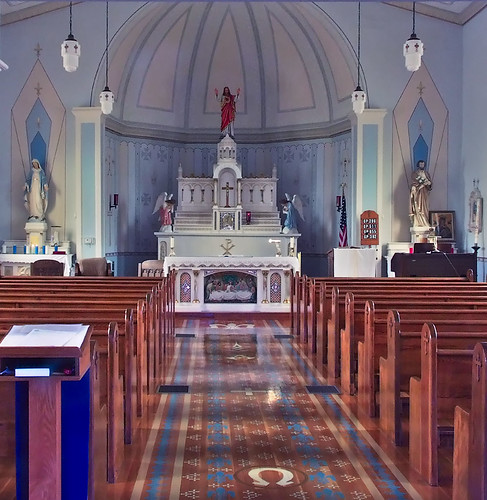
Saint Anne, mother of the Blessed Virgin Mary, has a strong devotion among the French; and perhaps not too surprisingly, her husband, Saint Joachim, has a church nearby.
Although the church was locked, I was able to take these photos through a window in the front door. Above the altar is the Sacred Heart of Jesus. The floor is decorated with fleurs-de-lis and the Greek letters alpha and omega.

The tabernacle, with sanctuary lamp glowing.
Sunday Mass at 8:30 a.m., and 6:30 p.m. on holy days of obligation. Confession Sundays at 8:00 a.m.
Click here for a location map.

According to a plaque on the front of the church:
Petit Canada (French Village) was visited by explorers and missionaries in the early 1700's. Later mid-century miners leaving the King's Highway at Bloomsdale established a permanent camp here on their way to Old Mines. The first settlers were French Canadians involved in fur trapping and mining. By 1797 there were 20 furnaces around French Village smelting ore. Although Mass had been offered by passing missionaries earlier, in 1828, Saint Anne's was established as the first permanent parish in St. Francois County. The priest rode from Ste. Genevieve to say Mass in a log church for 18 families. Twenty years later Father John Anselm became the first resident pastor. At this time St. Anne was one of only 48 parishes in the entire state and served 525 members. The present church was built in 1871-1874 and rebuilt after a fire in 1919. At various times, St. Anne ministered to Catholics at Bloomsdale, Zell, Lawrenceton, Farmington, and Bonne Terre. As mining moved into the richer producing "Lead Belt" during the last half of the 1800's, French Village became primarily a farming area. The role of St. Anne Parish reversed and it became a mission of Bonne Terre, then Bloomsdale and Lawrenceton. From 1964 to the present it is again a mission of Bonne Terre. Today this beautiful country, as always, is an attraction to visitors and challenge to numerous new settlers.Petit Canada changed its name to French Village when it established a post office.
The cemetery has a predominance of French and Irish names — these two nationalities having a long history of good relations — as well as a scattering of eastern European surnames. The name 'Aubuchon' seems to predominate here, with the oldest monuments spelling the name 'Au Buchon'. This cemetery has a number of ornate wrought iron crosses as monuments. Here is the grave of George Washington Brooks (1854-1937), a freed slave who served the same family for six generations; during the Civil War, he rode from French Village through guerrilla territory with $1000 in gold hidden in his boots for safekeeping.
Saint François County was originally a colonial district, and is named after Saint Francis of Assisi (1181-1226). Locals pronounce the name 'Francis'.

Saint Anne, mother of the Blessed Virgin Mary, has a strong devotion among the French; and perhaps not too surprisingly, her husband, Saint Joachim, has a church nearby.
Although the church was locked, I was able to take these photos through a window in the front door. Above the altar is the Sacred Heart of Jesus. The floor is decorated with fleurs-de-lis and the Greek letters alpha and omega.

The tabernacle, with sanctuary lamp glowing.
Sunday Mass at 8:30 a.m., and 6:30 p.m. on holy days of obligation. Confession Sundays at 8:00 a.m.
Click here for a location map.
Thursday, January 17, 2008
Photos of Saint Mary's of the Barrens Church, in Perryville, Missouri
HERE ARE PHOTOS of Saint Mary's of the Barrens Church, in Perryville, Missouri. Located in Perry County, this church is home to the National Shrine of the Miraculous Medal. The church is about 81 highway miles south of downtown Saint Louis, Missouri.
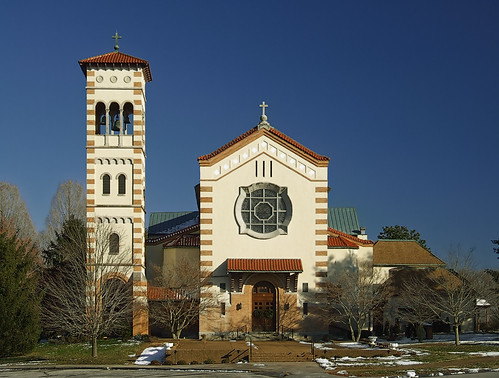
According to the history of the shrine:
Both Perryville (founded in 1821) and Perry County (organized in 1820) are named after Commodore Oliver Hazard Perry (1785-1819), the "Hero of Lake Erie"; he was a U.S. Naval officer who served in the War of 1812 against England, and is known for writing "We have met the enemy and they are ours..."
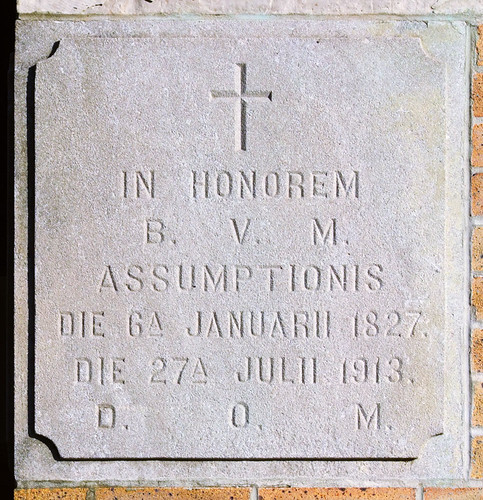

The interior of this pilgrimage church is richly painted.
The church seems much larger than it actually is. Perhaps this is because it adapts the design of a much bigger church. According to a plaque, "The church is a one third scale model of the chapel at Monte Citorio, the Vincentian motherhouse in Rome". This church has eight side-chapels, including the National Shrine.
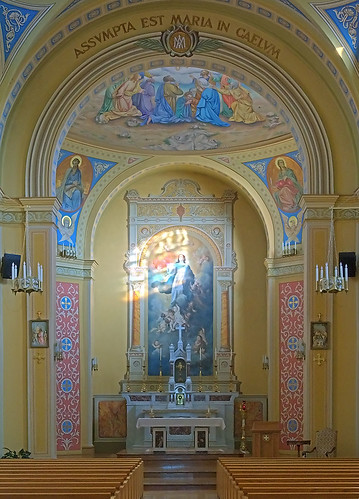
The church has a large sanctuary; on the back wall is a painting of the Assumption.
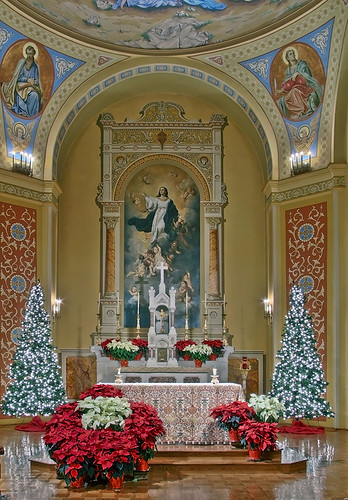
The sanctuary decorated for Christmas.
These photos were taken on two separate occasions: once in the daytime during Advent and the other at night during the season of Christmas.
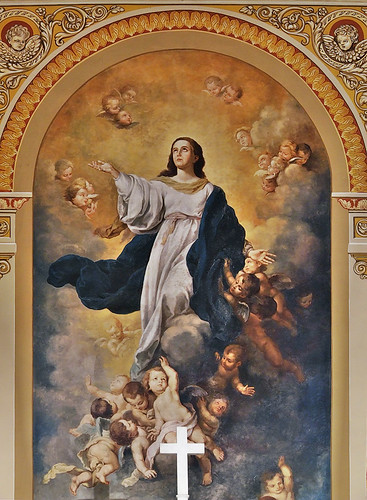
The beautiful painting of the Assumption of the Blessed Virgin Mary.
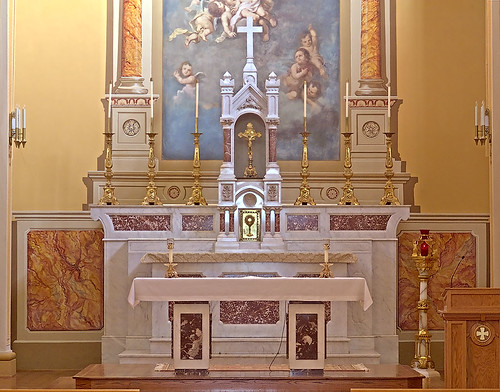
Saint Mary's of the Barrens is not a typical Catholic church name for the Archdiocese, for the earliest parishioners were English-speaking Catholics from Maryland. 'Barrens' is an English word for grasslands; hereabouts we usually use the French name 'prairie'.

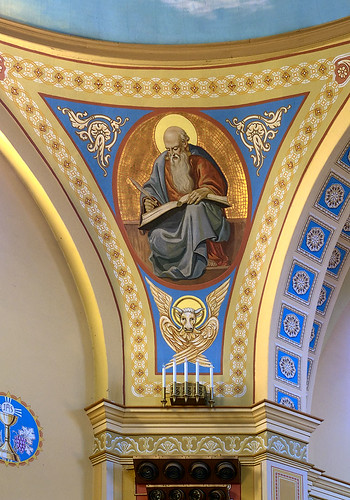
The sanctuary is beneath a dome supported by four columns; above each column is a painting of an Evangelist; here is Saint Luke.
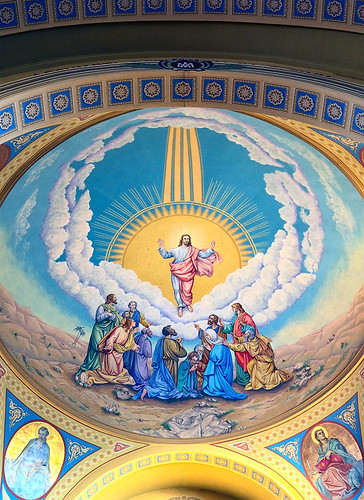
Painting of the Ascension above the sanctuary.
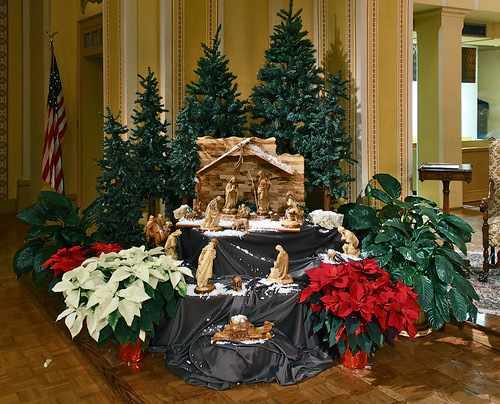
Christmas crèche.
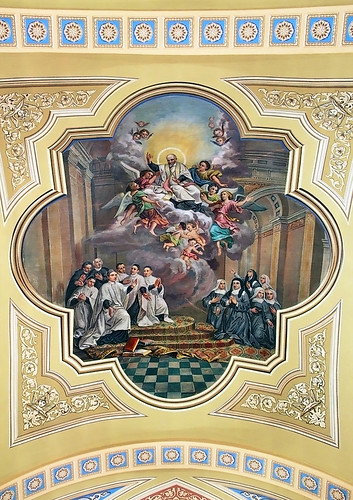
On the barrel-vaulted ceiling of the nave is this painting of Saint Vincent de Paul (1581-1660), founder of the Daughters of Charity and the Congregation of the Mission (also known as the Vincentians or Lazarists).
Many of the Saints portrayed in this church, like Saint Vincent, are Parisian.

FELIX CAELI PORTA
Happy Gate of Heaven
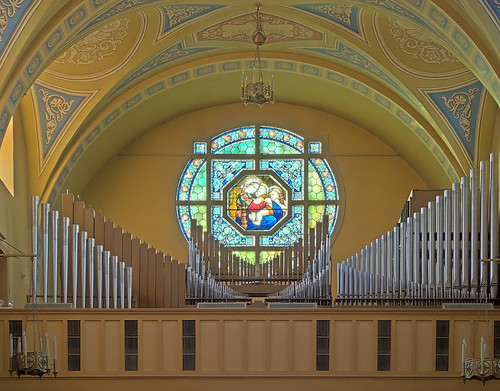
The pipe organ.

An exterior view of a stained glass window at night.
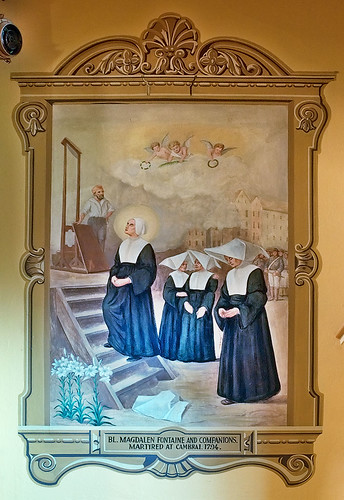
Painting of Bl. Marie Magdalene Fontaine and her three companions, approaching the guillotine to be martyred.
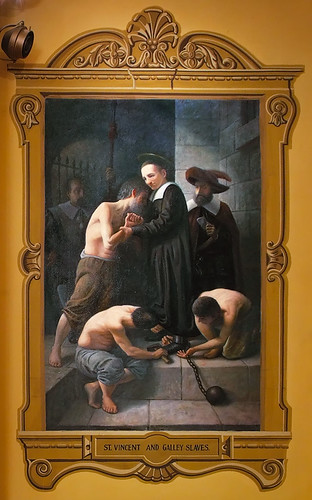
Saint Vincent de Paul ministering to galley slaves.
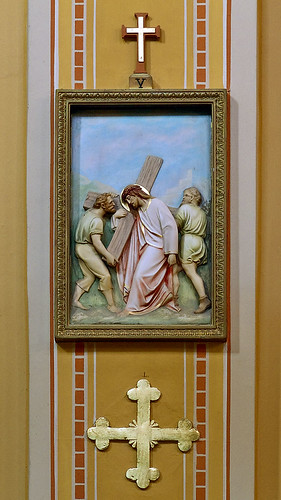
Station of the Cross and one of the church's Consecration Crosses.
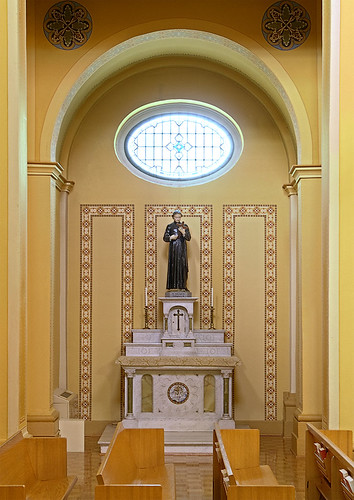
Altar of Saint John Gabriel Perboyre (1802-1840), Vincentian priest and martyr in China.
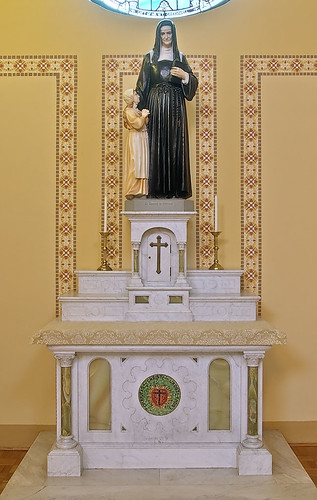
Saint Louise de Marillac (1591-1660), co-founder of the Daughters of Charity, founder of the Sisters of Charity.
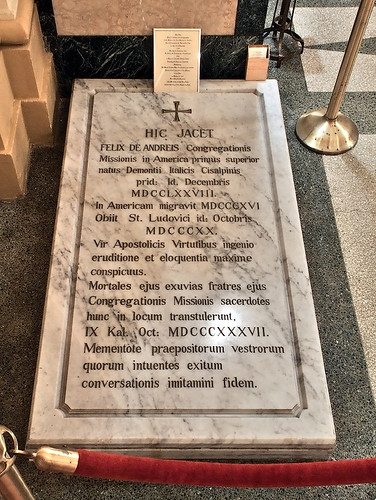
Tomb of the Venerable Felix De Andreis (1778-1820), priest and first Superior of the Congregation of the Mission in the United States. There are a number of other tombs beneath the floor of the church.
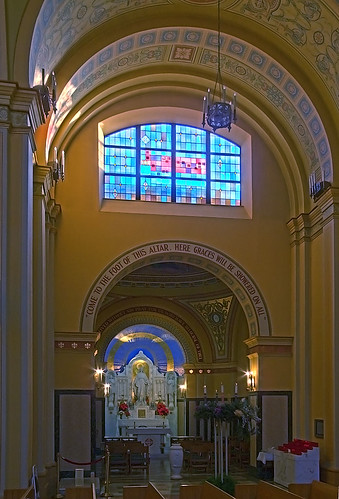
On the side of the nave is the National Shrine to Our Lady of the Miraculous Medal, added to the church in 1929-1930.

Starting in 1830, Saint Catherine Labouré (1806-1876) had visions of Our Lady, leading to the devotion of the Miraculous Medal.
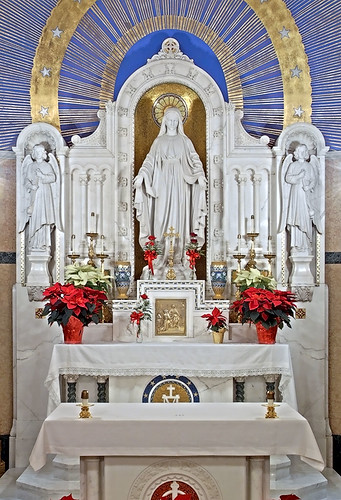
The shrine altar.
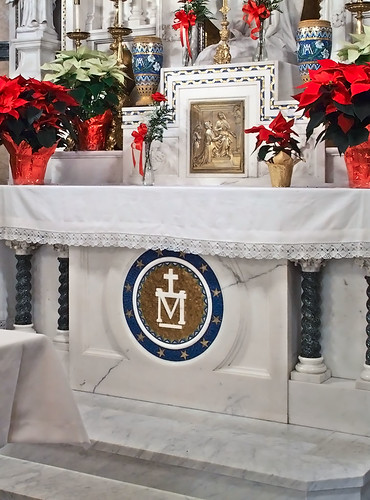
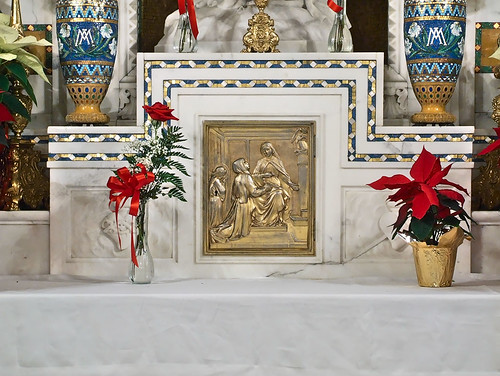
Unusual scene is depicted on the tabernacle door. To the left and right are the Sacred Heart and Immaculate Heart.
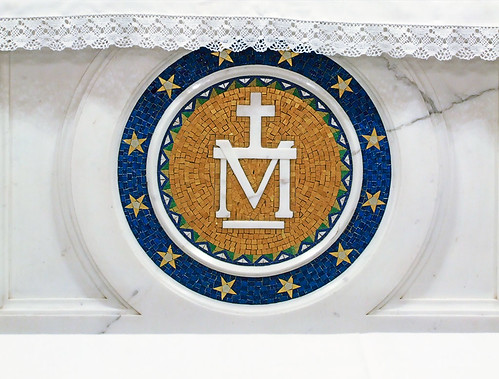
On the front of the altar is Mary's monogram, as shown on the Medal.
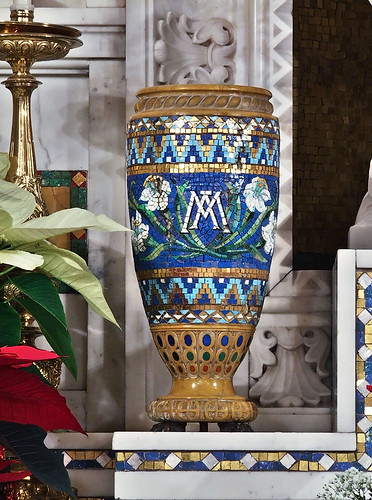
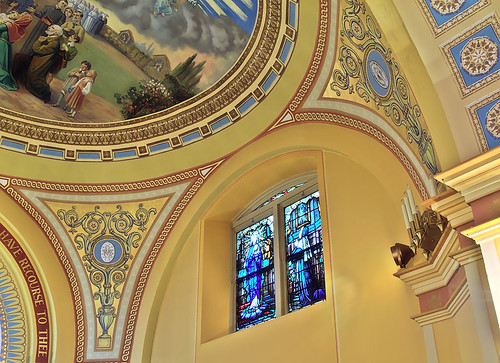
The stained glass windows in the chapel depict Mary's apparitions to Saint Catherine.
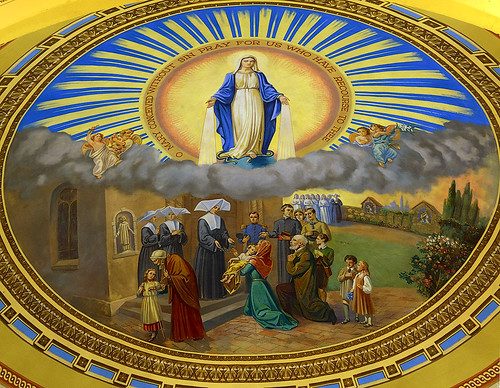
The chapel ceiling has a copy of a painting found at the Mother House of the Daughters of Charity in Paris. The top of the painting shows Mary as she appears on the Medal; below shows Saint Catherine distributing medals to the people of Paris.
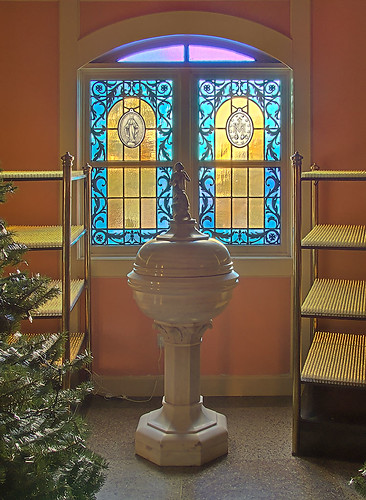
Adjacent to the shrine is the votive light room, which features tens of thousands of little lights for prayer intentions. Here is also the baptismal font, and a stained glass window depicting the design of the Miraculous Medal.

Ceiling above the baptismal font.
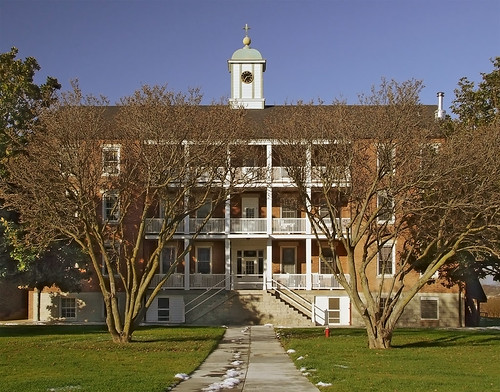
Old seminary building.
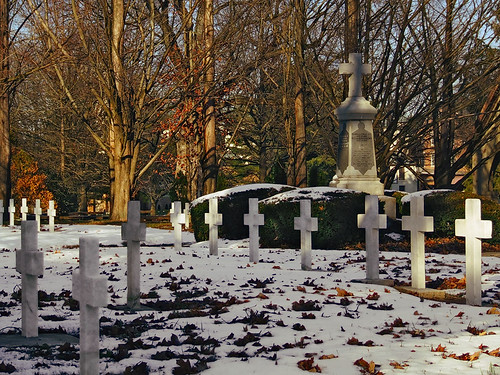
Vincentian cemetery.
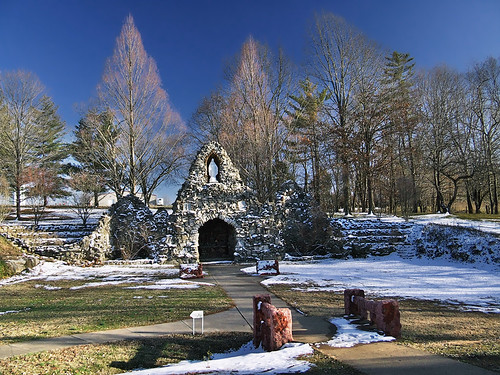
From the shrine history:
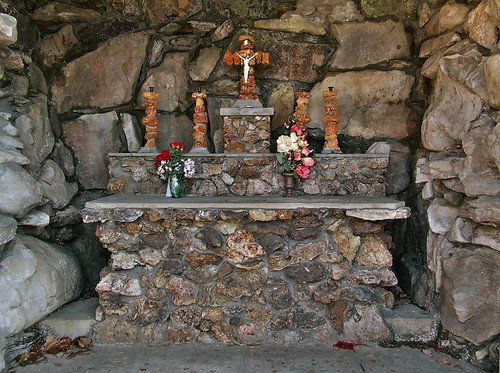
The grotto's altar.
Address:
1811 West Saint Joseph Street
Perryville, Missouri 63775

According to the history of the shrine:
The founding of St. Mary's of the Barrens, Perryville, Missouri, predates the founding of the State of Missouri by two years. In 1818 Father Joseph Rosati and a small group of Vincentian Missionaries were sent from Bardstown, Kentucky, to begin the church here. The first structure built at the time of Father Rosati was a small log cabin which is still preserved under a shelter just south of the Shrine. On January 6 The First College, 1827, the foundation stone for the present church was laid, and contributions from Europe helped local efforts to complete and consecrate the structure in October, 1837.The Angelus bell tower dates from 1980, and matches the 1913 facade.
In 1823 the seminary received its charter from the Missouri Legislature to confer academic degrees, one of the first such charters issued. The seminary is the oldest institution of higher learning west of the Mississippi in the United States. It has among its graduates some of the most learned, saintly, and distinguished clergymen in the long history of the American Church, including many pioneer bishops and missionaries. From here went forth the first bishops of St. Louis, Monterey, Pittsburgh, Buffalo, Galveston, New Orleans, and mission areas of China.
The seminary was closed in 1863 and the students moved to Philadelphia. It was reopened in 1888, and many buildings were gradually added to the campus. The Church itself received a new facade in 1913. The sanctuary was rearranged for Masses facing the people in 1967. It was redecorated several times in its history, most recently in 1980.
The church of St. Mary's of the Barrens continued to function as a parish church until 1965 when it became an independent "public church" in which liturgical services are held regularly. St. Mary's of the Barrens is now a part of St. Vincent de Paul parish in Perryville.
Both Perryville (founded in 1821) and Perry County (organized in 1820) are named after Commodore Oliver Hazard Perry (1785-1819), the "Hero of Lake Erie"; he was a U.S. Naval officer who served in the War of 1812 against England, and is known for writing "We have met the enemy and they are ours..."

✝
IN HONOREM
B. V. M.
ASSUMPTIONIS
DIE 6A JANUARII 1827.
DIE 27A JULII 1913.
D. O. M.
IN HONOREM
B. V. M.
ASSUMPTIONIS
DIE 6A JANUARII 1827.
DIE 27A JULII 1913.
D. O. M.

The interior of this pilgrimage church is richly painted.
The church seems much larger than it actually is. Perhaps this is because it adapts the design of a much bigger church. According to a plaque, "The church is a one third scale model of the chapel at Monte Citorio, the Vincentian motherhouse in Rome". This church has eight side-chapels, including the National Shrine.

The church has a large sanctuary; on the back wall is a painting of the Assumption.

The sanctuary decorated for Christmas.
These photos were taken on two separate occasions: once in the daytime during Advent and the other at night during the season of Christmas.

The beautiful painting of the Assumption of the Blessed Virgin Mary.

Saint Mary's of the Barrens is not a typical Catholic church name for the Archdiocese, for the earliest parishioners were English-speaking Catholics from Maryland. 'Barrens' is an English word for grasslands; hereabouts we usually use the French name 'prairie'.


The sanctuary is beneath a dome supported by four columns; above each column is a painting of an Evangelist; here is Saint Luke.

Painting of the Ascension above the sanctuary.

Christmas crèche.

On the barrel-vaulted ceiling of the nave is this painting of Saint Vincent de Paul (1581-1660), founder of the Daughters of Charity and the Congregation of the Mission (also known as the Vincentians or Lazarists).
Many of the Saints portrayed in this church, like Saint Vincent, are Parisian.

FELIX CAELI PORTA
Happy Gate of Heaven

The pipe organ.

An exterior view of a stained glass window at night.

Painting of Bl. Marie Magdalene Fontaine and her three companions, approaching the guillotine to be martyred.

Saint Vincent de Paul ministering to galley slaves.

Station of the Cross and one of the church's Consecration Crosses.

Altar of Saint John Gabriel Perboyre (1802-1840), Vincentian priest and martyr in China.

Saint Louise de Marillac (1591-1660), co-founder of the Daughters of Charity, founder of the Sisters of Charity.

Tomb of the Venerable Felix De Andreis (1778-1820), priest and first Superior of the Congregation of the Mission in the United States. There are a number of other tombs beneath the floor of the church.

On the side of the nave is the National Shrine to Our Lady of the Miraculous Medal, added to the church in 1929-1930.

Starting in 1830, Saint Catherine Labouré (1806-1876) had visions of Our Lady, leading to the devotion of the Miraculous Medal.

The shrine altar.


Unusual scene is depicted on the tabernacle door. To the left and right are the Sacred Heart and Immaculate Heart.

On the front of the altar is Mary's monogram, as shown on the Medal.


The stained glass windows in the chapel depict Mary's apparitions to Saint Catherine.

The chapel ceiling has a copy of a painting found at the Mother House of the Daughters of Charity in Paris. The top of the painting shows Mary as she appears on the Medal; below shows Saint Catherine distributing medals to the people of Paris.

Adjacent to the shrine is the votive light room, which features tens of thousands of little lights for prayer intentions. Here is also the baptismal font, and a stained glass window depicting the design of the Miraculous Medal.

Ceiling above the baptismal font.

Old seminary building.

Vincentian cemetery.

From the shrine history:
The Grotto of our Lady of the Miraculous Medal was built by the seminarians during World War I. It has become a special center of devotion to our Blessed Mother since then. Construction began in 1917 and was completed in November 1920. The first stone was put into place on June 25, 1917. A small chapel recessed in the center of the grotto wall has a small altar made of fieldstone. In a small niche at the top of the grotto wall, directly above the small chapel, is a statue of our Lady of the Miraculous Medal. The statue of our Lady arrived August 5, 1920. The grotto stands at the site of the old quarry, behind the Mound of our Lady of Victory (originally known as "The Mound of Our Lady of the Fields"). Rock used to build historic Saint Mary's of the Barrens Church came from this site.

The grotto's altar.
Address:
1811 West Saint Joseph Street
Perryville, Missouri 63775

